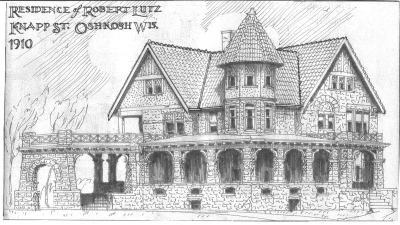
The following are examples of other common architectural styles found in Oshkosh.
Commercial buildings sometimes have a cornerstone with a date. This is the most obvious clue to its age, but it is not actually conclusive. Remember the European cathedrals which took centuries to complete! With homes, a dated cornerstone is less likely. Architectural style is the most common clue. In Oshkosh, Italianate and Queen Anne are common simply because those styles were popular during the time period when Oshkosh was growing.
Nineteenth Century Architectural Styles in Oshkosh
Greek Revival style was popular in the East during the years Winnebago County was being settled, falling out of favor at the time of the Civil War. Most commonly there is a gable end facing the street with a low-pitched roof. The triangular area just below the roof, known as a pediment, is outlined with molding. By the 1850s when most Oshkosh examples were built, the front door was found at one side. There may be a small pediment over the door.
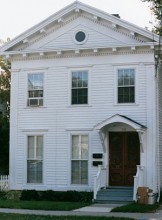
| 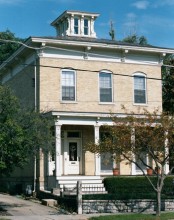
| 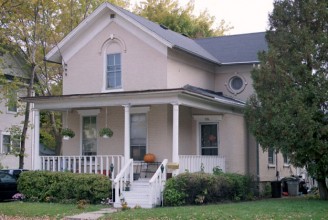
|
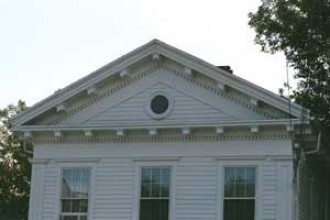
| 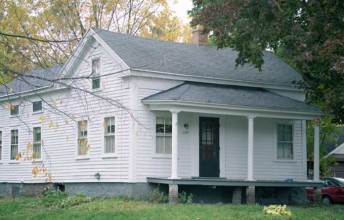
| 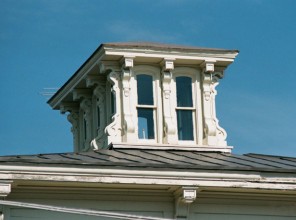
|
Italianate style is characterized by a low-pitched roof with a broad overhang. The molded brackets beneath this overhang lead to the alternate name of American bracket style. The homes are most often square and have long porches. Windows are placed symmetrically, sometimes to the point of having fake windows - frames with permanently closed shutters - to complete the pattern. This style was popular until the mid-1870s.
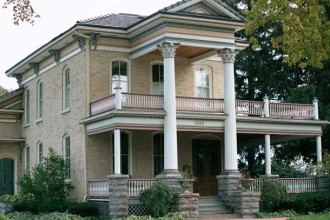
| 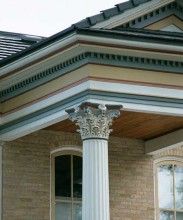
| 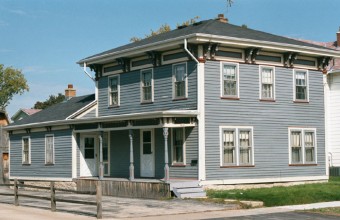
|
Second Empire style is characterized by the mansard roof and was highly popular between the Civil War and 1880. Few examples remain in Oshkosh.
Shingle style can be dated to the publication of an illustration in the New York Sketchbook of Architecture in January 1874. Like many styles, it was adopted first in the East and spread west from there. The exterior is not as irregular as in Stick or Queen Anne styles, with porches frequently an extension of the main building.
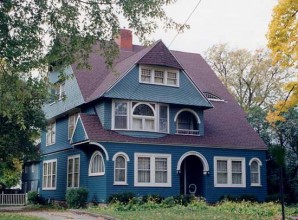
|
Stick style is named for its decorative crisscrossed timbers, or sticks, which are painted in contrasting colors. Overhangs, brackets, porches and balconies are also part of this highly decorated style.
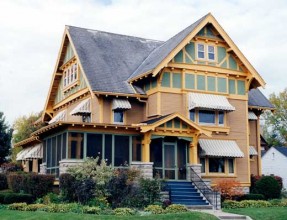
|
Bungalows are generally one or one and a half story homes. The porch is included under the same low, overhanging roof as the main house. Both inside and out, wood is stained rather than painted. Stone chimneys are common. The words "cozy" and "snug" are commonly used to describe the built-in window seats and breakfast nooks often found in this style.
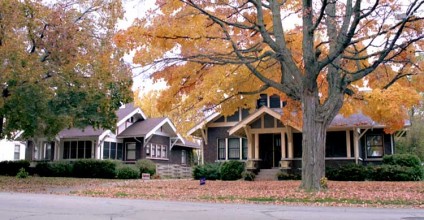
| 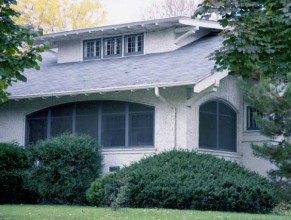
|
Colonial Revival, with its many variations, was inspired by the U.S. centennial of 1876, and continues to the present. These are two stories. The Dutch Colonial version includes a gambrel roof. The American Foursquare is a cube, with a single-story front porch, usually full width. Often there is a high attic, with a dormer window. These are large homes for the big families of the day.
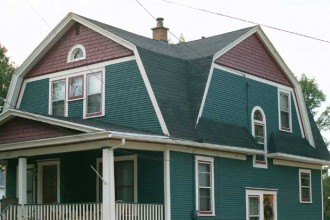
| 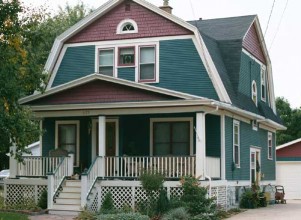
| 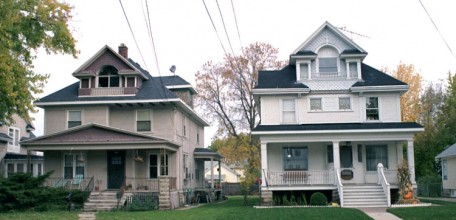
|
Picturesque Gothic Revival uses steeply pitched gables as focal points. These peaks are decorated with gingerbread woodwork cut into swirls. Similar trim tops each porch post. Grant Wood's famous painting "American Gothic" shows a farm couple standing in front of a picturesque gothic house.
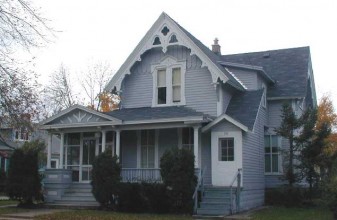
|
Queen Anne style was featured in several buildings at the 1876 Centennial Exposition in Philadelphia. From there it swept west. The irregular rooflines, with gables, turrets, towers and molding, called for woodworking skills readily found in Oshkosh. Not surprisingly, it was a favorite of local lumber barons.
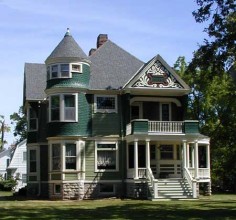
| 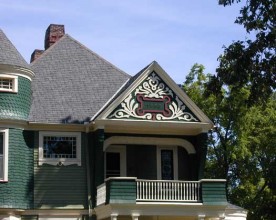
| 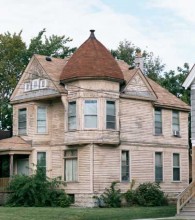
|
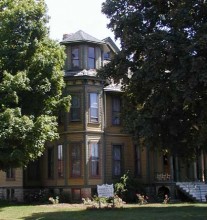
| 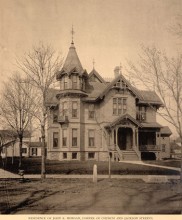
|
From the Weekly Northwestern, 11 Dec 1884, page 11:
"Mr. Waters is of the opinion that the present tendency to build houses in the Queen Anne style will continue for some times to come and run out in a short time after the usual custom of all styles which have had an extensive run in a short period. This style of house as the popular rage has been in favor in the east for a considerable length of time and is now gaining greater strength each year in the west, and by far the greater number of residences put up in this part of the country lately have been of this style."
Oshkosh Architects
William Waters
The most prolific of local architects was William Waters. He was born in New York in 1843. He studied at the Polytechnic Institute at Troy NY, "taking a thorough course in architecture" according to one biography. Although he did not graduate, society then was less diploma conscious than now, and he readily found work in Oshkosh after his arrival in 1867. The city was growing fast; population rose from 9,346 in 1865 to 22,064 by 1885. The 1895 biography cited above claims he designed the Oshkosh city hall, all the schools, four churches, the State Normal School [UW-O], and "ninety per cent of the better class of family residences on both sides of the river." Most of the homes are what is commonly called Queen Anne. In addition to the common turrets and gables of that style, Waters frequently featured fine woods in the interiors, making good use of the local sash and door industry's skilled workers. He died in 1917. Unfortunately, there is no file of his plans.
Adam E. Bell
Adam E. Bell came to Oshkosh from New York in 1856. By 1879, he and his partner, E. W. Cole, had "done more in the building line than any other firm ever locating here." The John R. Morgan House, 234 Church St., was planned and built by Bell and Cole in 1884. They also built homes designed by others. In 1882, for example, they built the Moses Hooper house from plans by William Waters. The firm continued until the early 1890s.
E. E. Stevens
Ephriam E. Stevens was born in Maine in 1851 and came to Oshkosh as a child with his parents. He learned first masonry, then architecture by apprenticeship. He also served as a contractor and builder. His brother E. P. Stevens continued to work as a contractor after E. E. moved to architecture. E. E. Stevens submitted a design for the Oshkosh Public Library. His plan lost to that of William Waters but was impressive enough that the E. D. Smith Public Library in Menasha was built from a similar plan of his soon afterward. The original Merrill School was his design. Stevens also served as mayor of Oshkosh. He championed the purchase of land for North Park (now Menominee Park) and was voted out of office because of it. He died in 1907. Stevens Park on the east side of Oshkosh is named in his honor.
Additional Resources
- The Wisconsin Architectural & History Inventory includes a collection of information on historic buildings, structures, sites, objects, and historic districts throughout the Wisconsin & the city of Oshkosh. Search by Winnebago County & the city of Oshkosh for houses of various architectural styles.
- The Historic Resources Survey for the City of Oshkosh, 2006 identifies properties that possess architectural or historical significance. The survey focuses on selected areas of the city and property types identified by the city.